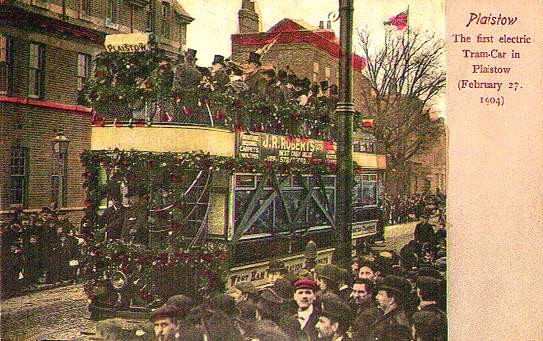

February 2004 was the centenary of the opening of the electric tramways owned by West Ham Corporation, in the eastern part of London. Our postcard is captioned "The first electric Tram-Car in Plaistow (February 27. 1904) " and indeed shows that first car, car number 1, which was decorated for the occasion with 900 lamps and carried local civic dignitaries. The photograph was probably taken at the crossover in Balaam Street near the Abbey Arms. The card is number 7 in what is called 'Serie Plaistow' and was published by 'Edmund Düsédau, London-Plaistow'. It was printed in Germany.
The North Metropolitan Tramways Company operated a number of routes across the borough and in 1898 the Corporation obtained powers to operate these lines and set about trying to purchase them from the NorthMet. In 1903, the NorthMet agreed to continue operating the routes with horse cars until such time as West Ham electric cars could take over. In 1900 West Ham obtained powers to build a number of their own lines and construction commenced in 1903. A temporary depot was erected in West Ham Lane pending building of a permanent depot and works in Greengate Street, and the first route was completed early in 1904 running from Stratford Broadway via West Ham Lane, Plaistow Road, Plaistow High Street and Balaam Street to the Abbey Arms.
At 12 noon on Saturday 27th February 1904 the Mayoress turned on the power at the depot and a convoy of 10 cars left the depot, led by number 1 driven alternately by the Mayor and the Chairman of the Electric Lighting and Tramways Committee, proceeding to Stratford Town Hall and then over the route to Abbey Arms and back to the depot. Public service began at 4pm on the same day.
Car number 1 was one of a batch of 50 open-top trams built for West Ham in 1904 by G.F.Milnes and Co. Ltd. of Birkenhead. They had Brush type "A" standard gauge 4-wheel trucks to a 6 ft. wheelbase, having Witting Eborall motors controlled by B.T.H. type B18 controllers. The trams seated 56 passengers and were painted in Munich Lake and pale cream with gold lining and had a red diamond painted on the dashes around the headlamps to distinguish them from the vehicles of the surrounding tramways. (See also Historic Photo.)
West Ham worked routes jointly with their neighbours East Ham, Leyton, Walthamstow, Barking and the London County Council Tramways. Opening new routes and taking over from the NorthMet, the system expanded to around 17 miles of route in the borough and post-WW1 with the through running commitments, the fleet expanded to 156 vehicles plus 2 water cars. Open-top cars were enclosed with covers built at the Greengate Street works and some trams were also built there. West Ham became the biggest and some would say the best of the London local council tramways.
London Transport came into existence in 1933 and soon took on a policy of replacing trams with trolleybuses. By 9th June 1940 the last tram had run in the East End streets, but the West Ham bogie cars built in the late 1920s and early 1930s for the trunk routes to Aldgate were transferred to South London where they continued to run until the end of trams on 5th July 1952.
![]() Go to Postcard Of The Month Index
Go to Postcard Of The Month Index